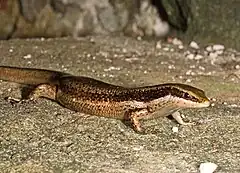| Mabuyini | |||
| Mittleman, 1952[1] | |||
 Przedstawiciel podrodziny – Mabuya dominica | |||
| Systematyka | |||
| Domena | |||
|---|---|---|---|
| Królestwo | |||
| Typ | |||
| Podtyp | |||
| Gromada | |||
| Rząd | |||
| Infrarząd | |||
| Rodzina | |||
| Podrodzina | |||
| Plemię |
Mabuyini | ||
| Typ nomenklatoryczny | |||
|
Mabuya Fitzinger, 1826 | |||
| Synonimy | |||
| |||
| Rodzaje | |||
| |||
Mabuyini – plemię jaszczurek z podrodziny Lygosominae w obrębie rodziny scynkowatych (Scincidae).
Zasięg występowania
Plemię obejmuje gatunki występujące w Ameryce[6], Afryce i Azji; jeden gatunek (Heremites auratus) także na niewielkim obszarze południowo-wschodniej Europy[7].
Podział systematyczny
Do plemienia należą następujące rodzaje[8]:
- Alinea Hedges & Conn, 2012
- Aspronema Hedges & Conn, 2012
- Brasiliscincus Hedges & Conn, 2012
- Capitellum Hedges & Conn, 2012
- Chioninia Gray, 1845
- Copeoglossum Tschudi, 1845
- Dasia Gray, 1839
- Eumecia Bocage, 1870
- Eutropis Fitzinger, 1843
- Exila Hedges & Conn, 2012 – jedynym przedstawicielem jest Exila nigropalmata (Andersson, 1918)
- Heremites Gray, 1845
- Lubuya Horton, 1972 – jedynym przedstawicielem jest Lubuya ivensii (Bocage, 1879)
- Mabuya Fitzinger, 1826
- Manciola Hedges & Conn, 2012 – jedynym przedstawicielem jest Manciola guaporicola (Dunn, 1936, 1935)
- Maracaiba Hedges & Conn, 2012
- Marisora Hedges & Conn, 2012
- Notomabuya Hedges & Conn, 2012 – jedynym przedstawicielem jest Notomabuya frenata (Cope, 1862)
- Orosaura Hedges & Conn, 2012 – jedynym przedstawicielem jest Orosaura nebulosylvestris (Miralles, Rivas Fuenmayor, Bonillo, Schargel, Barros, García-Pérez & Barrio-Amorós, 2009)
- Panopa Hedges & Conn, 2012
- Psychosaura Hedges & Conn, 2012
- Spondylurus Fitzinger, 1826
- Toenayar – jedynym przedstawicielem jest Toenayar novemcarinata (Anderson, 1871)
- Trachylepis Fitzinger, 1843
- Varzea Hedges & Conn, 2012
- Vietnascincus Darevsky & Orlov, 1994 – jedynym przedstawicielem jest Vietnascincus rugosus Darevsky & Orlov, 1994
Uwagi
- ↑ Pisownia oryginalna, takson zdefiniowany w randze podrodziny.
- ↑ Typ nomenklatoryczny: Euprepes Wagler, 1830; nomen oblitum.
- ↑ Typ nomenklatoryczny: Eutropis Fitzinger, 1843; nomen oblitum.
- ↑ W części.
- ↑ Typ nomenklatoryczny: Chioninia Gray, 1845.
- ↑ Typ nomenklatoryczny: Dasia Gray, 1839.
- ↑ Typ nomenklatoryczny: Trachylepis Fitzinger, 1843.
Przypisy
- 1 2 M.B. Mittleman. A generic synopsis of the lizards of the subfamily Lygosominae. „Smithsonian miscellaneous collections”. 117 (17), s. 4, 1952. (ang.).
- 1 2 L.J.F.J. Fitzinger: Systema reptilium. Fasciculus primus, Amblyglossae. Vindobonae: Braumüller et Seidel, 1843, s. 22. (łac.).
- ↑ K.R.G. Welch. Herpetology of the Old World 2. Preliminary comments on the classification of skinks (family Scincidae) with specific reference to those genera found in Africa, Europe and southwest Asia. „Herptile”. 7 (4), s. 26, 1982. (ang.).
- ↑ Hedges i Conn 2012 ↓, s. 28.
- 1 2 3 Hedges i Conn 2012 ↓, s. 29.
- ↑ Hedges i Conn 2012 ↓, s. 28–29.
- ↑ R. Midtgaard: Family Scincidae. RepFocus. [dostęp 2024-01-15]. (ang.).
- ↑ P. Uetz & J. Hallermann: Higher taxa: Mabuyini. The Reptile Database. [dostęp 2024-01-27]. (ang.).
Bibliografia
- S.B. Hedges & C.E. Conn. A new skink fauna from Caribbean islands (Squamata, Mabuyidae, Mabuyinae). „Zootaxa”. 3288 (1), s. 1–244, 2012. DOI: 10.11646/zootaxa.3288.1.1. (ang.).
This article is issued from Wikipedia. The text is licensed under Creative Commons - Attribution - Sharealike. Additional terms may apply for the media files.